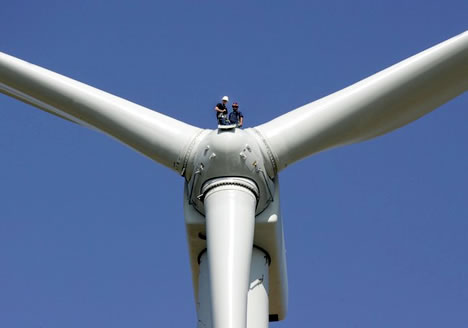More and more, smaller utilities are being created to nurture more sustainable forms of energy, and this is a good thing, however the movement of that energy is big business and according to Leonard S. Hyman, a Senior Associate at R.J. Rudden Associates, Inc in New York, the future deterioration in electric system reliability will surly happen if appropriate regulatory incentives are not provided and inadequate spending on infrastructure continues.
Hyman is the author of a report titled "The Next Big Crunch: T&D Capital Expenditures," which describes an alarming pattern regarding the lack of spending in electric transmission and distribution infrastructure.
Mr. Hyman attributes the sector's lack of activity in capital system improvements to a number of causes and describes the gap as "too large to ignore."
While lately, more is being spent on infrastructure it in no way covers the past years of lack of investment. Hyman asks, "Has the industry become astoundingly more efficient in managing its capital expenditures or should we expect the spending plans to rise dramatically?"
The report postulates that deregulated activities diverted money away from investing money on system improvement and replacement, in favour of steering funds toward deregulated activities with the potential promise of a higher return than regulated assets could earn. Regulators, inadvertently, encouraged the same pattern when they implemented price caps as part of bargains that liberated generating assets from regulation.
Now the bill is coming due.
Financially, the utility and energy sectors are under tremendous pressure to pay off debt. Mr. Hyman predicts that filings for rate increases will be necessary to cover the costs of new capital needed for the higher level of spending required to maintain reliability.
Sound familiar?
BC Hydro operated under a rate freeze for 10 years until rate increases were approved for 2004 and 2005. Many argue that the rate freeze caused BC Hydro to postpone or sideline the crucial upgrading of its extensive power grid.
Much of Hydro's infrastructure -- major transmission lines, dams and power generation stations -- were built in the 1960s and 70s. As Hydro chief executive officer Bob Elton told The Province's editorial board: "We're at the point where a lot of our equipment is getting old and it needs upgrading."
In other parts of Canada and in most of the United State, a mosaic of small utilities controls the electrical landscape. Most of them including the larger utilities like BC Hydro were accused of being complacent about eroding infrastructure, but that all changed August 14th, 2003 when fifty million people lost power in the Northeast and Midwest US and in Ontario, the worst blackout ever in North America and one that blamed inadequate transmission infrastructure as being partly to blame.
Since then we have all become aware of the problem, but solving it is still a bit of a mystery. What Americans quickly discovered was that if power failed in one part of the country, the economy was impacted for the entire country, so they began to pass laws like a new Reliability Act, which held utilities responsible for mismanaging transmission infrastructure.
Today, the average US electricity customer loses power for more than three hours annually – outages that cost the US economy about $80 billion.
That may be about to change.
America's power grid has a new cop on the beat, ready to slap stiff fines on power companies that don't meet new national standards for grid reliability. The standards became mandatory this past month.
Reliance on voluntary guidelines and collegial cooperation among power companies is out. Fines of as much as $1 million a day are in – levied by the North American Reliability Corp. (NERC), which is freshly armed with a federal mandate.
Some say that it marks a new generation of better reliability for wholesale electric power trading, with NERC as lead enforcer overseeing eight regional enforcement units, and one that may lay the groundwork for a future Canadian reliability formula.
That 2003 blackout lasted four days in parts of eight states and Ontario, it cost the US and Canada at least $4 billion. After that, Congress got tough – or tried to.
Though the US Department of Energy endorsed mandatory reliability standards back in 1997, it took the 2003 blackout to push Congress into passing the Energy Policy Act of 2005. As a result, more than 100 guidelines have been updated and transformed into stiff requirements.
Tree trimming along power lines, for example, is no longer discretionary. No longer is there any flexibility on credentialing operators who work in power-plant control rooms.
Mandatory rules governing grid reliability "were very much needed ... and long overdue," says Alison Silverstein, a consultant who helped investigate the 2003 blackout.
Within the industry, many agree on the need for mandatory national standards to deal with a power grid that has become much more complex. Since deregulation in the 1990s, hundreds of new players have entered the power industry.
Here at home, BC Hydro is a crown corporation and as our main utility in the province a slightly different layer of reliability might be required, which is one between communities and the utility.
When outdated infrastructure becomes overloaded, utilities now have become known to introduce rolling blackouts into the grid. A Rolling Blackout refers to an intentionally-engineered electrical power outage, caused by insufficient available resources to meet prevailing demand for electricity. These rolling blackouts became somewhat common in California during peak energy periods. One serious one was in August 2005 due to the loss of a key transmission line; the transmission line shut itself off because of a faulty sensor.
Then there’s the brownout used by eastern US utilities, in this scenario, instead of the power being cut off altogether to a certain percentage of customers, the voltage is reduced by a certain percentage to all customers — the resulting dimming of electric lights being the origin of the term "brownout." Brownouts can cause significant damage to unprotected electronic equipment, but usually have no effect (other than reduced performance) on incandescent lights or some types of motors.
Practises such as these might be in our future unless communities in the Okanagan begin to include electrical reliability with their community planning. When a proposal for a transmission line is slowed or rejected, our community leadership should be asking the utility where is the hydro going to come from to serve a development? Is existing electrical reliability going to be impacted?
When we see trees encroaching on hydro lines and not being maintained in the right-away or an increase in power outages, we should ask the utility, are they spending enough in our community to maintain electrical reliability?
Ask for community reliability reports from BC Hydro.
And most of all, ask your MLA about guaranteed electrical reliability. New sustainable energy sources are great, but they don’t do us a lot of good if that electricity can’t be delivered.
(30)
Most of California is divided into 14 power grids, each containing approximately 7% of electricity customers in the state, creating a total of 98%. The remaining 2% are placed on a separate grid, where users such as hospitals and police stations are exempt from ever having their power deliberately cut off.
In a Stage 1 emergency only a general call for voluntary conservation is issued, while a Stage 2 emergency results in power being temporarily cut off to certain large users, primarily industrial concerns, who have agreed to this arrangement in exchange for lower rates.
When a Stage 3 power emergency is declared, electricity to one of the grids is shut off for a fixed period of time, which can range from 60 minutes to 2½ hours. If after this period of time the Stage 3 emergency still exists, power is restored to this grid but then the next grid in the sequence is blacked out, and so on, until the situation is stabilized — the blackout thus "rolls" from one grid to the next.
In California, each customer's electric bill includes the number of the power grid from 1 to 14 that customer belongs to. This gives customers at least some advance notice of when their electricity might be turned off in the event of a Stage 3 emergency.
The grids are set up in such a manner as to ensure that a large percentage of customers in the same neighbourhood would not be blacked out concurrently, which could invite looting and other related problems. Normal electricity customers can fall within the areas reserved for emergency use (if they are near a hospital or other critical infrastructure), in which case their electricity bill will indicate a power grid of 99 and they will not be affected by rolling blackouts.
(30)


